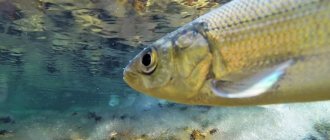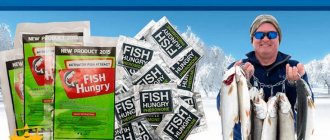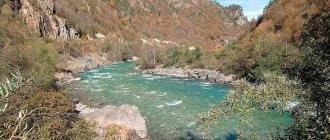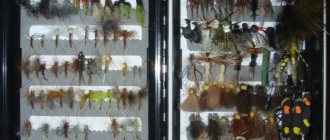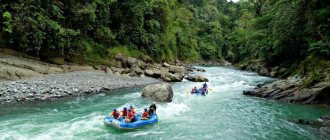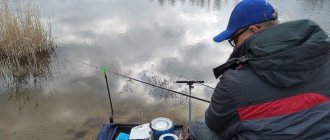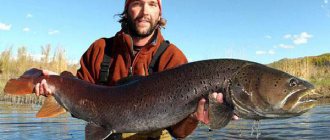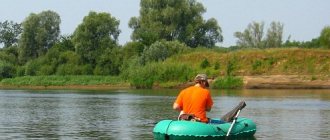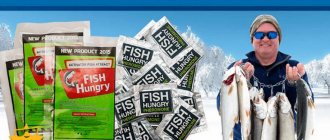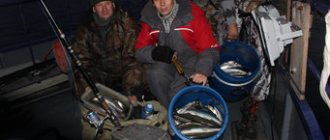Chub of the mountain rivers of the Caucasus
Photo: Gennady Shelyag.
One day, one of the inexperienced fishermen saw several large fish on the shallows.
He didn’t have a fishing rod, he only had a piece of thick fishing line and a large hook.
And this eccentric didn’t come up with anything smarter than winding a fishing line around his palm and, putting a live lizard on the hook, throwing it under the noses of the standing giants.
One of them furiously attacked the offered bait and, being immediately hooked, rushed into the depths.
DRAMATIC DENOUNIUM
The line on the palm tightened and cut the skin of the wrist. The large fish pulled forcefully into the depths, causing unbearable pain to the unlucky fisherman. Fortunately, he was not alone and in a heart-rending voice called a friend for help. Together they defeated the giant and dragged him to shore.
The skin on the arm was torn off several centimeters, and the wound was bleeding heavily. It's good that you had a first aid kit with you. But still, the hand of the lucky winner of the trophy had to be seriously treated.
Read the material “How to protect yourself from ticks?”
This terrible story of the 60s of the last century left me in awe and made me treat a fish called chub very respectfully.
BITTERED BY WASPS
Then two events occurred that strengthened my respect for this fish. Once I met a friend coming from fishing, in whose net I saw a chub weighing about one and a half kilograms. In my understanding, for a small Hosta it was a real monster.
Later we caught chub on a stretch with a large tree fallen into the water. We caught them using processed cheese and wasp larvae, which we called “wasps.” Actually, getting wasp nests, where we took bait from, is a different story. Let me just say that wasps protecting their offspring have bitten us more than once.
| The main external difference of the Caucasian chub is the absence of red fins. Photo: Gennady Shelyag. |
THE FISH WAS SAVED BY A TREE
In the company of our peers, we caught several decent chubs weighing 100–200 grams. Suddenly my brother got a bite from a big one. He turned around after hooking on the surface, showing himself in all his glory and confirming that he was indeed a chub, and then rushed under a tree that had fallen into the water, hooked the fishing line on the branches and, taking advantage of our confusion, fell off.
It was a real tragedy for all the kids, my peers, who watched this event.
BIG FISH IN SMALL RIVERS
Having finished the artistic introduction, I will tell you about chub fishing in the mountain rivers of Sochi and Abkhazia, such as Khosta, Sochi, Kudepsta, Gumista and Kodor. The chub lives in almost all large, medium and small rivers flowing into the Black Sea.
Read the material “The Chir River - I made the right decision”
Moreover, it is one of the most elusive migrants of these rivers. It often survives in small rivers such as the Kudepsta, where the water level becomes very low during the summer months. When trophies weighing more than one or even two kilograms are found in the deep holes of this river, it causes real amazement.
FOOD RATION
Since the chub is a predator, its food range in mountain rivers is very diverse. During adolescence, it feeds on insect larvae that go through their developmental stages in the water, and on juvenile fish of all kinds. Once a chub reaches a certain size, it requires larger, higher-calorie food.
At this time, it feeds on all small-sized living creatures that accidentally and not accidentally find themselves in the water. These include fallen insects, larvae, earthworms, minnows, roach, gobies, lizards, and small snakes. Teenagers of podust, barbel, trout and even the chub themselves also become the object of his hunt.
| Photo: Gennady Shelyag. |
FISHING AS A RELEASE
As we see, chubs in mountain rivers do not lack food. Its main enemy is powerful floods and great fishing pressure. Sport fishing is developing at an ever faster pace every year. And this is not surprising.
Today it has become an outlet in a crazy race for survival. I can say with complete confidence that a person who spends his weekends with a fishing rod in his hands is spiritually and morally much healthier than someone who “relaxes” in front of the TV or computer.
Read the material “Greed in hunting has been and will be”
And if he also turns off his mobile phone and all communication lines connecting with the world of civilization, he is a real hero.
SPECIAL CHUB
Why is the Caucasian chub special? For many reasons. Firstly, it looks different from the middle zone chub. Large individuals do not have red fins; in the Caucasian chub they are simply gray. In addition, it has a more elongated and slender body shape.
Secondly, the harsh conditions of survival in mountain rivers cannot be compared with the living conditions in the fast and clean rivers of the middle zone. Anyone who has ever observed a phenomenon called an avalanche in mountain rivers will understand me.
AVALANCHE ON A MOUNTAIN RIVER
After a rainstorm or tornado in the mountains, river levels rise tenfold. And then, for a short time, the small stream turns into a raging mud flow, carrying branches, roots and tree trunks, overturning multi-ton blocks of stone and changing its bed beyond recognition.
Read the material “Where to look for fish after a change in water level”
How the fish of mountain rivers, including the chub, survive in this hell remains one big mystery to me. I think some of the fish are washed out to sea, the rest are hidden in deep holes under rocks and other large shelters. One way or another, as soon as the water level returns to normal and the water is cleared, the fish are right there, as if there was no natural disaster.
| In such a large river of Abkhazia as the Kodor, fishing with a spinning rod is much more effective. Photo: Gennady Shelyag. |
WHY MUCH BACKING?
Since the chub is a predator, it is the most delicious object for fly fishers and spinning anglers. For fly fishing, rods up to class 4 are used, depending on the size of the river. A reel of the appropriate class must accommodate a line with a leader and leader, as well as a minimum of 100 m of backing with a strength of 20 lb.
I advise you to keep this amount for the Black Sea trout that is accidentally tempted by your fly. This fish is truly crazy, capable of reeling tens of meters from a reel in a matter of seconds.
TAKE EVERYTHING FROM FISHING!
It’s nice to prolong the torment before a large brown trout tears off the thin leader, unwinding all the backing from the reel. It will make you worry as long as possible and run through the water and along the shore in an attempt to “land” the monster with light tackle.
This is exactly why you need a backing reserve of 100 meters (personally, I always keep 150 meters, just for peace of mind).
EVERYTHING GENIUS IS SIMPLE
As a leader material, it is better to use fluorocarbon from 0.1 mm to 0.17 mm, depending on the fishing conditions and the class of gear used. The classic leash length is the length of the rod (possibly with a handle).
Read the material “Spinning without hooks”
Tapered monofilament and fluorocarbon leaders should only be used when dry fly fishing using the dead swim method. In all other cases, it is better to use a cylindrical leash connected to a loop of a floating cord. Nothing extra, everything is brilliantly simple!
| Every trophy caught with sports gear is a real holiday. Photo: Gennady Shelyag. |
FLIES USED
All flies should be tied with a loose loop, allowing the front sight to take a more natural position when retrieved.
The range of flies is selected depending on the time of year and the river in which you are fishing. The usual hook size on flies is 8-12.
When selecting flies, the main emphasis should be on small nymphs with golden heads and small streamers. Dry flies are only good to fish when you see fish feeding on the surface.
CAUTION AND AGAIN CAUTION
In addition to the floatant, when fishing for chub, you must have a synket with you to degrease the leader after tying the fly. The chub, especially the large one, is a cautious and sensitive fish. You should fish reaches and holes with a slow current as carefully as possible. The main focus when searching should be on deep holes with minimal current flow.
| Photo: Gennady Shelyag. |
ADVANTAGES OF SPINNING
At times, spinning for catching chub in mountain rivers has advantages over fly fishing. Using spinning baits with long deep leads, it is much faster to fish large reaches with weak and medium currents. In addition, when the fish are inactive and standing deeper in holes, spinning fishing also becomes more effective.
Read the material “Parade of homemade donks”
For chub fishing, spinning rods from ultralight to 10–15 grams are used, spinning reels ranging in size from 1000 to 2500 according to the Shimano and Daiwa classification.
FISHING LINES AND LURES
A braided fishing line with a thickness of 0.1–0.13 mm with classic winding on a reel at 1–2 mm to the side of the spool is suitable. Those who like to use fluorocarbon and regular fishing line use them with a thickness of 0.17–0.21 mm. When fishing with braided line, the bait is tied on a fluorocarbon leash 50–70 cm long and 0.18–0.2 mm in diameter.
To catch the cunning fish of the Caucasian mountain rivers, a wide variety of spinning baits are used. The important thing is the size of these baits - from 1.5 cm to 5–6 cm.
You can use wobblers, spoons, spinners, microjigs and some other baits. It all depends on your experience and the predilection of the fish in a certain body of water for certain baits.
| Working dimensions of oscillating spoons with a single hook. Photo: Gennady Shelyag. |
ENTER THE GATE WITH WORTH!
Catching special Caucasian chub in special Caucasian mountain rivers is a special experience. This is searching, detecting, tracking and squatting to catch points.
The chub is a cautious fish, which does not allow its fishing to be treated unprofessionally. There are, of course, completely random catches of large trophies. They occur more often in those who can be called real hard workers when fishing.
It is to those who search, try, experiment that the underwater fish kingdom opens its gates. Enter these gates with dignity and remember that each of us bears the responsibility for preserving aquatic biological resources.
And everyone is responsible for the cleanliness of our water bodies. Good luck!
Gennady Shelyag October 12, 2021 at 05:25 pm
Mountain fishing.
High water in the Amur and its tributaries, flooded banks. Impression, there are no fish here. It would seem that you can give up on fishing... I suggest you discover an alternative - fishing on mountain taiga rivers. If this is your first experience, then you will discover the wonderful world of the Far Eastern taiga, crystal clear waters and the rather peculiar inhabitants of these waters. October is perhaps the most suitable time for such fishing, since it is during this period that fishing becomes easier, more confident, and does not require much knowledge in this area.
It is in October that the so-called fish migration occurs. What does it mean? Fish do not winter in the upper reaches of rivers, since they often freeze and there is no constant influx of fresh, oxygen-bearing water. Grayling and lenok live in mountain rivers; unlike Amur fish, they cannot live in water with a low oxygen content. And they will not fall asleep, unlike, again, Amur fish. Accordingly, with the arrival of low temperatures (September - October), snow often already falls in the mountains, many places in the rivers are intercepted by ice, the water level drops, there is also little food, and the fish begin to roll into wintering pits (these are the deeper parts of the rivers, where freezing and often there are underground springs that bring oxygen; aquatic benthos remains here - nutrients).
What do we need? The minimum fisherman's kit for fishing on a mountain river includes the following components. Wading boots or a wading suit (overalls), made of rubberized fabric, or specially treated nylon, that is, from so-called non-breathable materials that do not allow water to pass through and allow you to move in the water. Since this type of fishing is called wading: you are at least ankle-deep in water, and at most waist-deep. Boots on the Khabarovsk market cost from 900 rubles, a wading suit from 2,500 rubles.
Disadvantages of such a suit.
- All the heat, all the moisture that your body releases when you move remains in your suit. Consequently, the clothes get a little wet from the inside, and therefore you may freeze.
- Weight of overalls.
- The sole of the boots of the overalls, although corrugated, is still quite slippery. It’s just designed to move through silt, mud, and you will move over stones with a coating of algae.
Waders
So be careful! There is an alternative. You can purchase a specialized wading suit, waders, which are made from two types of fabric - gore-tex (breathable) or neoprene (foam rubber sandwiched between two layers of fabric), similar materials are used in diving suits. There are two types of waders: those immediately equipped with boots, or those with wading boots included separately. These suits are specialized in mountain fishing - the soles of their shoes are made of artificial felt, which does not slip when walking, it does not rot and is not afraid of water. It’s much more comfortable to walk around while fishing in this outfit!
The price of waders with boots (made of neoprene) is from 3,500 rubles. Waders for boots (made of gore-tex material) - from 4,500 rubles. Boots with felt soles - from 3,000 rubles.
The next thing you will need is a fishing rod. The fishing rods used are quite specific. How are they different? Firstly, it's lightness. After all, the fishing rod is in your hand during the entire fishing period. Secondly, it is compact. If we are in open areas and don’t move around much, the compactness of the fishing rod is not so important for us. But there are times when we need to move along the river bank or along the river itself, often littered with fallen trees (the so-called windbreaks), and then compactness is extremely important.
Fishing rod
If your fishing rod is long, it will be very awkward for you to move around with it. Therefore, the recommended length (for example, for rivers like the Khor or Anyui) is from 3.5 to 5 meters. In addition, the fishing rod should be quite rigid in action (the fishing rod that you used to catch the same crucian carp will not work). I advise you to inquire further about the specifics and differences between these two types of fishing rods from the consultants of specialized stores.
The next point is kan (aka haryuzyatnitsa, box). This is a small container that you carry with you and put caught fish there. It is inconvenient to return to the shore all the time to leave the fish there, or it is inconvenient to carry a fish tank with you. This could be a wicker basket of a specific configuration, a plastic box, or, as a last resort, some use a cut-off rectangular plastic canister. When there is nothing else to replace it with, they even use plastic bags.
Equipment. Again, it's a little different. Floats are used with a medium load capacity (from 3 to 8 g), usually round or oval in shape, without long antennas, with one end weight, from which there is usually an attached leash with a hook. Ask consultants in city stores about equipment options (you need clarity here).
You can go mountain fishing and spinning. The only thing is that you don’t need to use a long one (the rivers are not that wide). The usual length of a spinning rod for mountain fishing is 2.1-2.4 m, according to the test - from 5 to 45 g, with a fast action. Among the baits are spinners (according to the accepted size of bluefox 3, 4 - if we are working on lenka and 5 - if we are working on taimen), wobblers (with medium and small depth, the shape of which is mainly “minou” and “gobies”). But, believe me, getting to know mountain fishing is more interesting with a fishing rod! This option is much more exciting and productive. Spinning still has specifics that you need to learn from more experienced fishermen, or gain your own experience. The fishing rod is much simpler in this regard.
Bait
Bait. Artificial baits are used. They are called differently: chemistry, flies, jigs, etc. This is an imitation of aquatic insects made using natural and synthetic materials. These baits have a wide variety of shapes and colors; in almost all specialized stores in the city they are presented in a fairly large assortment.
Since we will be fishing in the fall, flies of various orange (from dark terracotta to bright, chemical), green (from dim khaki to dark marsh) colors are suitable. I can advise. It makes no sense to take one fly. It is very difficult to guess which fly will work. Experienced fishermen go fishing with sets of up to a thousand pieces. It is clear that you will not immediately acquire such a collection. The minimum set you will need for the first time is 10-15 pieces. Prices: from 25 rubles for a factory-made bait, up to 140 rubles for a hand-knitted one by a famous craftsman. Today - just briefly about what is necessary. Well, in the next issue we will tell you about fishing techniques and fishing mountain rivers in our region.
